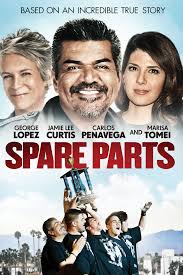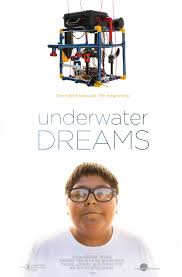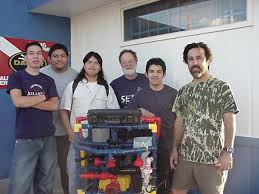Any of the discussion questions can serve as a writing prompt. Students can be assigned to fill out and present full paragraph responses to the questions contained in TWM’s Film Study Worksheet for a Work of Historical Fiction (for Spare Parts) or Film Study Worksheet for a Documentary that Seeks to Persuade on Issues of Political or Social Significance (for Underwater Dreams).
Additional assignments include:
1. These movies offer an opportunity to get students to read. The book is Spare Parts: Four Undocumented Teenagers, One Ugly Robot, and the Battle for the American Dream by Joshua Davis, the journalist who broke the story of the Carl Hayden Robotics team. It is an excellent, readable, in-depth description of the students, the teachers, the events leading up to the victory, and the events afterward, including the painful and heroic decision by Oscar Vazquez to return to Mexico and his fight to come back to the U.S. as a legal resident. Students who see the film will be very interested in reading the book. For a post-reading writing assignment, students can be asked to list the differences between the book and the movie, to provide ten facts in the book that are not in the film, to discuss what most surprised them when the read the book; or to describe the different reasons each of the four Carl Hayden students had for signing up for the robotics club, etc.
If there isn’t time to read the entire book, certain chapters may be of interest to different students, although TWM bets that kids assigned to read a portion of the book will be so interested that they will read more than the specific pages assigned to them. For example, students can pick their favorite among the four students and read the sections of the book relating to that student. The following selections include the description of the school and the immigration situation in Phoenix as well as information about the particular students. Sections of the book about Lorenzo, whose characterization in the movie varies more from the real Lorenzo than the characterizations of the other students, are at pp. 9 – 19, 31 – 36; 74 – 76; 193 & 194 and 222; the selections relating to Cristian are at pp. 15 – 36; 70 – 76; 190 – 192, 222; the sections relating to Luis are at pp. 15 – 19; 31 -36; 74 – 76; 81 – 84; 222; and the sections relating to Oscar are at pp. 15- 19; 31 – 53, 74 – 76; 77 – 80; 195 – 218, and 222. The following pages relate to the stories of the teachers: Fredi Lajvardi: 15 – 19; 54 – 66; 85 & 86 and 222; Alan Cameron: 15 – 19; 62 – 69; 85 & 86, and 222.
2. Write an essay about your most inspiring teacher and how that teacher affected you.
3. Write a persuasive essay advocating for your position on the Dream Act and President Obama’s Deferred Action for Childhood Arrivals.
4. One of the students said, “We are American in every way but paperwork.” Is this true? What does it mean to be an American? Suggested Response: The United States is the only country in the world in which, except for the Native Americans, if you go back only a few hundred years, everyone is from somewhere else. All that it takes to be a full-fledged American is to adopt American ideals and pledge your allegiance to the country. While there are immigrants in other countries who are accepted and live their lives in their adopted nations, they are always different from the people who were born there. In the U.S. that’s not a difference because our relatives, perhaps distant relatives, but our relatives were also from somewhere else and became Americans when they accepted American ideals. What are the American ideals? Well, politically, they are set out in the Declaration of Independence and the Constitution. But there are also a host of other ideals that are important to the American ideal. A good exercise is to ask the class what they think they are. Here are some suggestions: religious and political tolerance, democracy, freedom of speech and association, the rule of law, individualism, etc.
See also Additional Assignments for Use With any Film that is a Work of Fiction.







